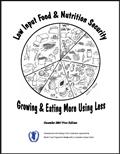
|
Published in : 2005 Available in : English, Portuguese Keywords : food and nutrition security, permaculture The manual presents a step by step and hands-on approach to achieve food and nutrition security. The manual is a result of a investigative study in 2005 in Malawi which covered over twenty programmes that that were running between 1-10 years. The purpose was to determine an appropriate model for improving food diversification in food insecure communities, families with chronically ill members, and students (including young children). The result of the study is a model helping people to first understand issues and then to help people choose and adapt interventions that will work for their situation. This is where the mindset of farmers and implementers, including most of us, has failed and needs to change. We need to reconnect with the core issues and create sustainable designs that are appropriate to our situation. To address the challenge of diet diversification inside our food security projects and overcome high grain dependency, the manual encourages education and demonstrations of a wide variety of species i.e., fruits, vegetables, legumes, animals, etc. (indigenous as well as those introduced) and medicinal plants (local varieties and introduced such as garlic, ginger, neem, etc.) throughout communities and around schools, health-centers and homes. Most importantly that we all begin to role model healthy, sustainable living in our work and in our homes, where ever we work and live in the world. Originally posted at : Low Input Manual download |
|
This resource is listed under: Themes : Household Food Security and community nutrition, general Life-cycle focus : Intergenerational focus Resource types : Field guide |
|